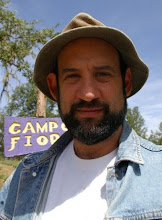 In the last article I talked about the baby lavender plants, all cozy and warm in their wood stove heated nursery just a few mile north. January is well underway, and it's time to start thinking about preparing a home for the children. Last week I agreed to come out today and start staking out the new fields... with none other than lavender stakes of course! But that was before I saw the weather. I woke up this morning, and yikes! She was really letting loose. I put on my hat and jacket to feed the chickens carrying an empty bucket with me. When I arrived at the coop, the bucket was full. That was how hard it was raining. I broke out my oil slicker and rubber boots for what promised to be a WET day!
In the last article I talked about the baby lavender plants, all cozy and warm in their wood stove heated nursery just a few mile north. January is well underway, and it's time to start thinking about preparing a home for the children. Last week I agreed to come out today and start staking out the new fields... with none other than lavender stakes of course! But that was before I saw the weather. I woke up this morning, and yikes! She was really letting loose. I put on my hat and jacket to feed the chickens carrying an empty bucket with me. When I arrived at the coop, the bucket was full. That was how hard it was raining. I broke out my oil slicker and rubber boots for what promised to be a WET day!The new field is going to be integrated into a functional landscape. And the terrain is not completely flat. So the field planning is a bit more complex than a simple rectangle with north-south running rows and irrigation. The first order of business is to determine exactly where the lavender are going to be planted. In this case, the landscape design company has provided me with some CAD renderings of the fields, but it is important to verify exactly where the fields are going to be, and take measurements for developing the field and irrigation plans.
Now, I have friends who's family farm cattle, corn, and wheat in Kansas. And they to a lot of their planning via satellite. In fact, it's amazing how much is done these days with technology. All those millions of dollars spent during the cold war to try to see where the nuclear missiles were going, are now helping farmers plan and manage their crops. Real whiz-bang Buck Rogers stuff. I suppose someone is still looking out for the missiles, but it's nice to know technology is being used for something constructive nowadays.
 But there is nothing better than working right on the ground. At least for me. So I broke out my really high-tech farming gear. Satellites ain't got nothing on a good measuring wheel and compass! They might not be fancy pants, but they git er done.
But there is nothing better than working right on the ground. At least for me. So I broke out my really high-tech farming gear. Satellites ain't got nothing on a good measuring wheel and compass! They might not be fancy pants, but they git er done.The work will be done in two stages. First, the field measurements. Second I'll draft up a set of field plans. Since I'm a visually oriented person, I like to have a map with me in the field while I'm taking the measurements. So I sat down this morning at the kitchen table with the CAD renderings and drew up a crude field map. I'll use this as reference. Then I hopped in the car and drove down to the site.
Now, remember the rain. Yeah, well, I'm not a duck. More importantly, without the proper writing instruments and laminated maps, trying to take notes in the middle of a biblical deluge is kinda tricky. So I have to admit, I sneaked a peak on the satellite, even though I was trying to be so Luddite. I could see that the front coming in off the ocean to the west was petering out. My estimates, I could go now and get soaked. Or wait an hour and get there during a break in the rain. Excellent. That was just the excuse to take one more cup of tea.
When I arrived, the storm tail was just passing. So I waited 10 minutes in the car for it to pass, and then got out and started my work. Using the map as reference, I picked obvious landmarks, labeled the map and took measurements. Namely distances and directions using the measuring wheel and compass. I recorded all of these for each field area on the field map.
The nice thing about being on the ground like this when marking the field is that you get a real feel for the soil and terrain. You can make adjustments for tree shade, drainage (helpful to notice when it has just rained!), buried utility boxes and sewers, as well as slope. Things that are just not present, or more difficult to feel on the satellite images. And more importantly, you get to be outside on a beautiful (albeit wet) day, wind in your face, enjoying the deer meandering by, birds, turkeys, cool mushrooms, and squirrels. Well, maybe not the squirrels (see my previous post on ground squirrels here). But you get the picture. Life couldn't be better.
Once the data was collected, I packed up the gear and headed home. Even with the rain gear, I got a bit wet. So I started a fire, took off my wet socks, and warmed up with another cup of tea. Rain started again. That's okay, we can use it.




 Today I made a quick winter check of the bees.
Today I made a quick winter check of the bees.
